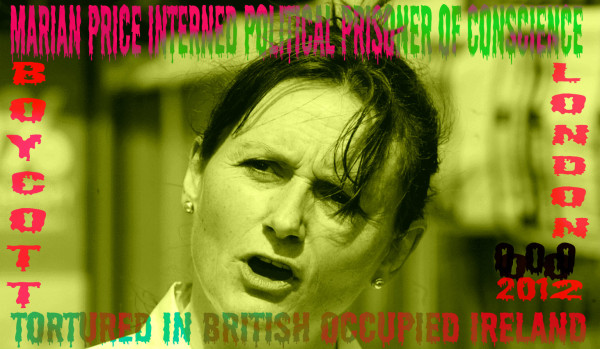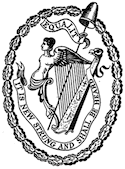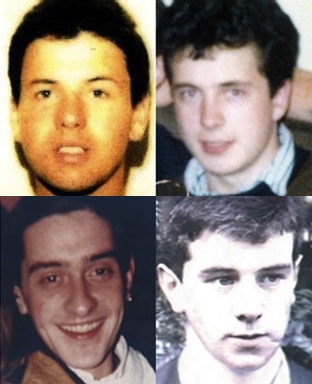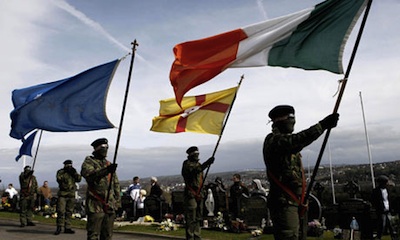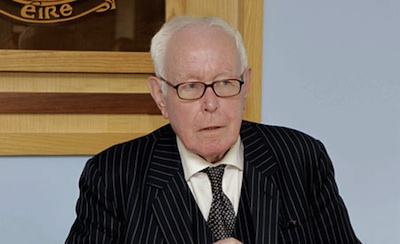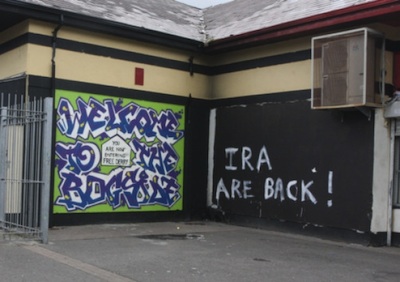Irish Peace Process Dying
 international | crime and justice | news report
international | crime and justice | news report  Tuesday August 07, 2012 04:12
Tuesday August 07, 2012 04:12 by BrianClarkeNUJ - AllVoices
by BrianClarkeNUJ - AllVoices 
Murder By a Mongol Tory Vice Royal
In British Occupied Ireland concentration camps such as Long Kesh happen ำvery decade or so and today the highlighted internment of the dying Marian Price is but one of many Irish political prisoners interned without trial. Marian who was force fed by the British for over six months was held in solitary confinement for close to a year is now in intensive care with acute pneumonia. Marian Price's condition is described as “serious” and her family has expressed deep concern about her deteriorating physical and mental health. Marian was moved from Hydebank prison to a unit of Belfast City Hospital, where she was receiving treatment for severe depression but her health continued to fail. On Tuesday last she was diagnosed with pneumonia and moved to the main hospital.
The English term "concentration camp" was first used to describe camps operated by the British in South Africa during the Boer War. When Kitchener became commander-in-chief in South Africa in 29 November 1900, the British Army introduced a new tactic to break the guerrilla campaign in South Africa. Kitchener attempted to "flush out guerrillas in systematic drives, like a sporting shoots, with a weekly 'bag' of killed or captured and wounded, sweeping the country bare of everything, that could sustain the guerrillas, including women and children. Of the 28,000 men captured as prisoners of war, 25,630 disappeared while 26,000 women and children were murdered by the British, the inventors of the original concentration camps. Of the extra 107,000 black Africans who were interned, the precise number of their deaths in concentration camps is unknown, as the British did not bother to count them.
In British Occupied Ireland concentration camps such as Long Kesh, happen every decade or so and today the highlighted internment of the dying Marian Price is but one of many Irish political prisoners interned without trial. Marian who was force fed by the British for over six months was held in solitary confinement for close to a year is now in intensive care with acute pneumonia. Marian Price's condition is described as “serious” and her family has expressed deep concern about her deteriorating physical and mental health. Marian was moved from Hydebank prison to a unit of Belfast City Hospital, where she was receiving treatment for severe depression but her health continued to fail. On Tuesday last she was diagnosed with pneumonia and moved to the main hospital.
Human rights activists and peace supporters are currently trying to organise an international human rights campaign, to pressurise the British establishment to immediately free Ms Price before it is too late.The prison authorities boarded up the windows of her intensive care room in hospital, until the staff protested against it. “Unless immediate action is taken to save Marian’s life, she, like Giuseppe Conlon in 1980, will die a prisoner, another innocent victim of the British ,” says Geraldine McNamara of Republican Sinn Féin. “Marian’s continued detention is yet another breach of human and civil rights by the British Establishment who continues to occupy the six north-eastern counties of Ireland.”
Marian's husband, Jerry McGlinchey, said: “We’re extremely worried. Marian has been in constant pain for months.Nobody has to agree with my wife’s politics to see this is wrong and violates her human rights.” Ms Price was interned without trial by British Direct Ruler Owen Paterson. Mr McGlinchey said: “I’ve nothing to say to Owen Paterson, but I appeal to the Justice Minister to show compassion and release my wife.” Sinn Féin’s Jennifer McCann said her party had confirmed the deterioration in Marian Price’s condition. “It is unacceptable that despite being moved from prison that she remains in custody with her historic licence still revoked,” she said.“It has long since passed the time when the British government moved to show some genuine compassion in this case and reinstate Marion Price’s licence and allow her to return to the care of her family without any further delay.“I will be making contact with the British government to continue to press them to release Marion Price before further damage is done to her health.
The destruction of the Peace Process in Ireland is a calculated one, where currently on the British side of the peace process equation, the Historical Enquiries Team (HET), in conjunction with the PSNI , are in the process of framing criminal charges against people who were active as combatants, when the war that was meant to be now ended in British Occupied Ireland, was still raging. Subpoenas served against the Belfast Project archive at Boston College, is an example of this activity but it is not by any means the only one. The political blessing was clearly given by the Tories, who regard PSF and the process generally as 'lefty crap'. They essentially have decided to resume the war and to put people who fought against them previously in the war in prison.
Dissident Unionists with whom Owen Paterson the present Secretary of State, has been working tirelessly for years to co-opt into his Tory party, now being led by Nigel Dodds and Maurice Morrow are only puppets, being used by the ‘securocrats’ of MI5 and MI6 who work quietly, ceaselessly, behind the scenes directing the current Anti Good Friday Campaign, which in essence, is a de facto abrogation of the peace deal by the British. Along with the sinister elements working quietly behind the scenes Foster and Morrow, have never supported the peace agreement and do not want it to work as they continue to prevent a sustainable just peace in Ireland to continue instead, with their Protestant State for a Protestant People, i.e permanently British for their mentors.
.
To confirm Tory intent to destroy the process, it has become clear within the past year that Paterson, MI5 and the PSNI are rolling out a covert form of Internment without trial in British Occupied Ireland, aside from the obvious ones in the instance of Marian Price and Martin Corey, they are remanding without credible evidence, many political activists, perceived as a threat to the Stormont state. Lengthy waiting times, courts which unquestioningly accept police statements, provided by war motivated British military intelligence and the political policing of the paramilitary PSNI system that detains, charges and remands republicans, with little or no evidence at all. Republican activists are being removed from the street for strictly political reasons for up to three years at a time, effectively bypassing any pretence of the civilised concept of ‘innocent until proven guilty’.or the centuries old protection of the Magna Carta or Habeus Corpus.
What we are witnessing, is the rebirth of the same old Orange scum state of fascist round up, or a so-called peace process without due process. This in fact is a process in which all freedom loving citizens who prove inconvenient to a scum state, face life in prison without due process. Sadistic animal killers and hunters of the the Tory horsey set in Irish and British society are now leading these draconian practices. Millionaire Tory fox-hunting aristocrat, Owen Patterson has overseen the kidnap of Marian Price and Martin Cory, both elderly, gravely ill, the innocent victims of political conscience, to orange sectarianism and British bigoted hatred of Irish republicans and equality. While they are currently not mainstream republican, no one has a monopoly on the truth or Irish republicanism and they are both long time members of the Irish Republican Movement, who have given all in the service of the Irish Republic.
In British Occupied Ireland concentration camps such as Long Kesh, happen every decade or so and today the highlighted internment of the dying Marian Price is but one of many Irish political prisoners interned without trial. Marian who was force fed by the British for over six months was held in solitary confinement for close to a year is now in intensive care with acute pneumonia. Marian Price's condition is described as “serious” and her family has expressed deep concern about her deteriorating physical and mental health. Marian was moved from Hydebank prison to a unit of Belfast City Hospital, where she was receiving treatment for severe depression but her health continued to fail. On Tuesday last she was diagnosed with pneumonia and moved to the main hospital.
Human rights activists and peace supporters are currently trying to organise an international human rights campaign, to pressurise the British establishment to immediately free Ms Price before it is too late.The prison authorities boarded up the windows of her intensive care room in hospital, until the staff protested against it. “Unless immediate action is taken to save Marian’s life, she, like Giuseppe Conlon in 1980, will die a prisoner, another innocent victim of the British ,” says Geraldine McNamara of Republican Sinn Féin. “Marian’s continued detention is yet another breach of human and civil rights by the British Establishment who continues to occupy the six north-eastern counties of Ireland.”
Marian's husband, Jerry McGlinchey, said: “We’re extremely worried. Marian has been in constant pain for months.Nobody has to agree with my wife’s politics to see this is wrong and violates her human rights.” Ms Price was interned without trial by British Direct Ruler Owen Paterson. Mr McGlinchey said: “I’ve nothing to say to Owen Paterson, but I appeal to the Justice Minister to show compassion and release my wife.” Sinn Féin’s Jennifer McCann said her party had confirmed the deterioration in Marian Price’s condition. “It is unacceptable that despite being moved from prison that she remains in custody with her historic licence still revoked,” she said.“It has long since passed the time when the British government moved to show some genuine compassion in this case and reinstate Marion Price’s licence and allow her to return to the care of her family without any further delay.“I will be making contact with the British government to continue to press them to release Marion Price before further damage is done to her health.
The destruction of the Peace Process in Ireland is a calculated one, where currently on the British side of the peace process equation, the Historical Enquiries Team (HET), in conjunction with the PSNI , are in the process of framing criminal charges against people who were active as combatants, when the war that was meant to be now ended in British Occupied Ireland, was still raging. Subpoenas served against the Belfast Project archive at Boston College, is an example of this activity but it is not by any means the only one. The political blessing was clearly given by the Tories, who regard PSF and the process generally as 'lefty crap'. They essentially have decided to resume the war and to put people who fought against them previously in the war in prison.
Dissident Unionists with whom Owen Paterson the present Secretary of State, has been working tirelessly for years to co-opt into his Tory party, now being led by Nigel Dodds and Maurice Morrow are only puppets, being used by the ‘securocrats’ of MI5 and MI6 who work quietly, ceaselessly, behind the scenes directing the current Anti Good Friday Campaign, which in essence, is a de facto abrogation of the peace deal by the British. Along with the sinister elements working quietly behind the scenes Foster and Morrow, have never supported the peace agreement and do not want it to work as they continue to prevent a sustainable just peace in Ireland to continue instead, with their Protestant State for a Protestant People, i.e permanently British for their mentors.
.
To confirm Tory intent to destroy the process, it has become clear within the past year that Paterson, MI5 and the PSNI are rolling out a covert form of Internment without trial in British Occupied Ireland, aside from the obvious ones in the instance of Marian Price and Martin Corey, they are remanding without credible evidence, many political activists, perceived as a threat to the Stormont state. Lengthy waiting times, courts which unquestioningly accept police statements, provided by war motivated British military intelligence and the political policing of the paramilitary PSNI system that detains, charges and remands republicans, with little or no evidence at all. Republican activists are being removed from the street for strictly political reasons for up to three years at a time, effectively bypassing any pretence of the civilised concept of ‘innocent until proven guilty’.or the centuries old protection of the Magna Carta or Habeus Corpus.
What we are witnessing, is the rebirth of the same old Orange scum state of fascist round up, or a so-called peace process without due process. This in fact is a process in which all freedom loving citizens who prove inconvenient to a scum state, face life in prison without due process. Sadistic animal killers and hunters of the the Tory horsey set in Irish and British society are now leading these draconian practices. Millionaire Tory fox-hunting aristocrat, Owen Patterson has overseen the kidnap of Marian Price and Martin Cory, both elderly, gravely ill, the innocent victims of political conscience, to orange sectarianism and British bigoted hatred of Irish republicans and equality. While they are currently not mainstream republican, no one has a monopoly on the truth or Irish republicanism and they are both long time members of the Irish Republican Movement, who have given all in the service of the Irish Republic.

